One of the most tense games you’ll ever play, Naughty Dog’s The Last of Us is at times brilliant, frightening, and moving. In fact, if it falls short at all, it’s only due to the sheer weight of expectation leading to the intense scrutiny of anything Naughty Dog produce. When you’re the best, people expect the best.
Such is the level of detail, it puts most other developers to shame. The Last of Us is, hands-down, one of the best looking games you’ll ever see. One early scene is so impressive that I managed to watch it play out in its entirety reflected back at me, having turned my character towards a glass patio door. Yes, that’s how high the level of detail in The Last of Us is. But such majesty is not in the grandeur of previous games Naughty Dog have developed (which I’m going to try to avoid mentioning by name), but rather in the beauty of the destruction, in the meticulous craftsmanship of every piece of environment. It’s in allowing you to suddenly, for the first time, find an attic in a building that you don’t even need to explore, that allows you to discover a hidden item you wouldn’t have found had you not simply stumbled across it.
It’s also in listening to Ellie express herself, baffled at an idea as mundane as a truck that sells ice-cream as you laugh along with Joel, because you share his knowledge of the “real world”, and all the lost things that he remembers and that Ellie has never experienced are common place to you. That moment is a flash of colour and personality that is sorely needed, because The Last of Us is an unrelentingly bleak story, full of pain, heart-ache and sadness. It’s the journey of Ellie and Joel across barren, hollow lands and through infected and dangerous locales, but it’s a journey you’ll never forget.
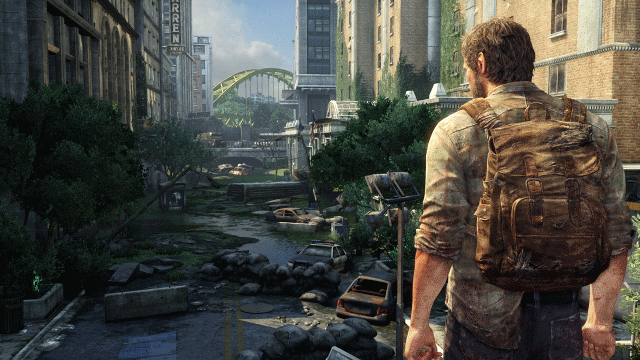
Aside from being one of the most visually arresting titles around, the performances of all the voice actors involved are simply astonishing. Ellie is one of the most believable characters, and though she’ll curse and display emotions that befit an older woman, moments of child-like beauty will catch you off guard as she starts singing a song, or discovering she can whistle for the first time. Joel, on the other hand, is grizzled, world-weary – a beaten man who doesn’t appear to know why he even keeps going. The constant back and forth between the two as their relationship evolves is wonderful, with moments of sheer terror as Ellie comes into the path of danger. Though she can protect herself to a degree, and will even occasionally find you supplies, you are Joel, you are her protector.
But it’s not just Joel and Ellie; the audio design (including the supporting cast) is absolutely phenomenal. Much has been made of the enemies you’ll encounter, and the Clickers are terrifying. Early in the game where you have little in the way of supplies and no way of protecting yourself as you can with the latter game upgrades, they are enemies that can, and will, kill you instantly. Creeping around environments, all the while knowing they are there, is incredible, and it’s in these moments that The Last of Us shines like no other game. The UI, from the very first moment you begin, is minimalist, which marries beautifully with the soundtrack. Half the time you won’t know it’s there, but the musical cues will teach you to know when you’ve been spotted, and react accordingly.
There’s not exactly a massive amount of enemy types, though, and it’s difficult to determine whether this is a design decision, or an effort to try to keep some form of realism in the world (after all, why would there be 20 different infected types, when it seems the infection has a clear path of destruction on the human body?) The Clickers are by far the most frightening; they can’t see you, but they can hear you, and the sparse audio design means that for those moments, you can only hear the breathing of you, the player, and the Clicker as you decide whether to fight, or take flight. Thankfully, Joel has “Listen Mode”, which allows him to focus on the surrounding area, listening carefully to identify threats. It’s this technique – activated by holding R2 – that means you can sneak round a Clicker, or (when you have the required skill) sneak up behind them and take them out with a shiv. Using Listen Mode also makes it easier for you to grab a glass bottle or brick, and throw it to distract or draw an enemy away – but be aware that some foes will eventually circle around to the source of the thrown object, so the solution is to throw and move; don’t be there when they go looking.
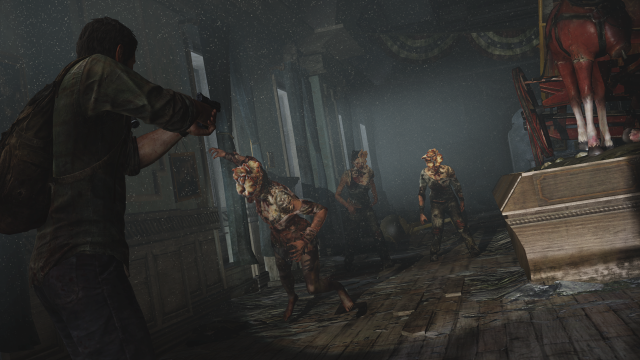
Runners are the other frequent enemy variant and, unlike the Clickers, they can see you. When they do, they will come at you in numbers, meaning you not only have a fight on your hands, but also that you’ll be making a tremendous amount of noise while you do it. Thus, the Clickers come into play, and you best make sure you’re a good aim, or have upgraded certain skills, because otherwise, you’re dead. Sometimes, escape is the best option – so use it.
Despite an emphasis early on towards stealth, The Last of Us is a shooter, too, and as you progress and find more and more weapons for offence and defence, there’s a slight tendency to veer towards the more destructive path, as you’re quite powerful. There’s no real way around this, although regardless of any arsenal you may possess, the infected enemies will still cause panic because you’ll never have enough ammo, and you’ll have to switch weapons regularly to survive. Melee combat is brutal, yet satisfying; Joel is a brawler, slugging his way through incredibly violent altercations with little grace.
Every encounter feels different, unique – even when you’re just in a gunfight with bandits. In fact, the AI is top notch, and they’ll flank you in a way you won’t expect. You’ll find that you’re so conditioned to relying on AI routine paths, that when a bandit circles round the houses in a huge, open-gully town combat situation and actually sneaks up on you, it’ll be a genuine surprise – even 10 hours deep.
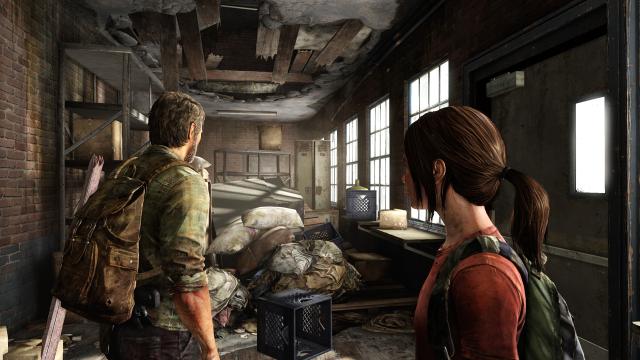
The only real negative mark, however, is immersion. Naughty Dog have gone to such incredible lengths to create this infected universe, that the presence of game-y mechanics can be jarring at times. For example, you might kill an enemy who clearly has a gun trained on you, but once he is dead, his gun has magically disappeared, and you can’t loot him for ammo. Yet another guy may drop ammo once you stealthily kill him, or indeed, an infected may do similar.
On your travels you will need to scavenge for all manner of in-game currencies, which all go towards crafting and upgrading your tools and abilities. Finding pills will allow you to shift things in Joel’s balance by improving your skills, and one vital skill to save up for early on is the ability to use a shiv to reject a Clicker’s grapple. Simply put: without this skill, every time a Clicker gets hold of you, you’re dead. Further upgrades allow for a longer distance Listen Mode, for instance, or a reduction in aim-sway (the aiming in The Last of Us is superb; Joel isn’t a soldier and this is reflected in the fact he can’t run and gun like some ridiculous ultra-marine), or even just raising Joel’s maximum health level.
In terms of crafting, there are limited things you can make. Health kits, shivs, molotov cocktails, and other items I won’t spoil here, make up your defensive and offensive capabilities, combined with guns that are also upgradeable thanks to salvage you’ll find throughout the world. You can also find training manuals that further upgrade miscellaneous skills such as blast radius, or the duration of some attacks.
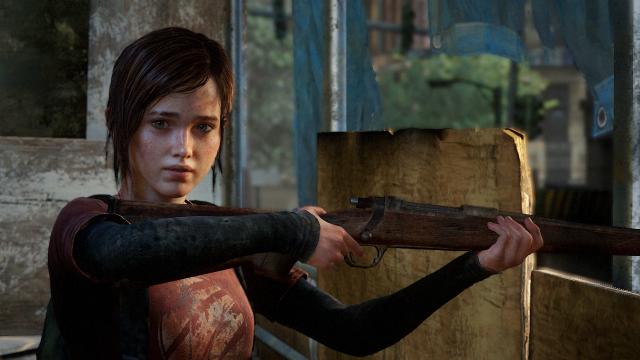
But none of this really hurts the game, thanks to some of the techniques Naughty Dog employ to create a realistic protagonist. Despite the obvious motion capture and facial animations, Joel is rendered more believable thanks to the little things. His movement feels real, and when hurt, he’ll stagger backwards, leaving him vulnerable to further attack – which is yet another reason not to get hurt in the first place. It’s enormously affecting that when the story beats happen, you’ll feel them along with Joel. Just about every part of The Last of Us is rewarding, because every facet is about engaging the person playing, and it absolutely works – not least in the incredibly strong opening and ending sequences.
But of course, no game is complete without a multiplayer component these days, and Naughty Dog have attempted to make things interesting with how it works. Rather than a simple X versus Y approach, you get to pick a faction to side with instead. Most of the mechanics from the single player game carry over to the multiplayer, and through the use of loadouts, you can find your preferred role in any match. Different skills change how you play: you might have high crafting speed ability (for example), so you can get that medi-kit created in no time at all. In fact, there are bonuses for doing certain things, so if you play with the pre-designed Support loadout you will be awarded a bonus item – a gift, if you will – to hand over to a team-mate after every two items you craft. The stealth loadout allows you to be invisible to other players’ Listen Mode when crouching, or will alert you when you’ve been marked by a opponent (the R3 stick allows you to mark bombs or enemies).
Not all mechanics from the single player campaign carry over entirely, but mostly this is to help balance. You can’t sprint forever, and you can’t pick up proximity bombs once laid – and it actually does work well. The idea is that you are representing your faction over a twelve week period, trying to hold out until a shipment arrives that could shift the balance of the fight in your favour. Collected salvage is converted into supplies for your faction, and the more people that join the clan will enable more bonuses, such as one-use boosters that can tip individual matches towards your faction.
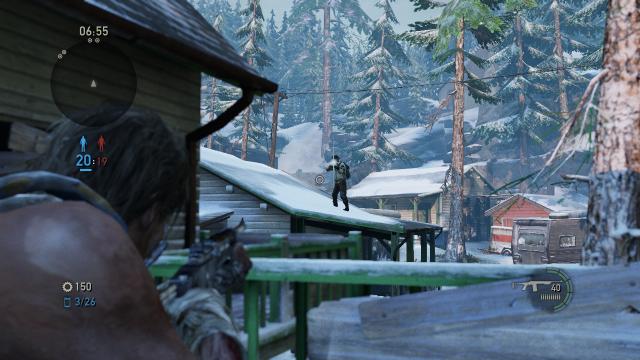
It’s a unique idea based around familiar mechanics that tries to tie itself into the fiction of the game world, though in truth it doesn’t quite manage it fully. There is plenty of customisation, and seven maps is a fairly generous helping, especially as they are big enough and have enough verticality that you never feel like you’re playing some generic online shooter. It feels slightly over-complicated at times, and some of the tension that is so impressively created in the single player is obviously lessened, but overall it’s a nice addition to a game that already boasts a lengthy 13-15 hour campaign, with multiple new game plus options (and you will need to play it again if you want to upgrade everything) – but it’s only ever going to be a side-dish to the main event.
VERDICT: The Last of Us is astonishingly beautiful and utterly compelling in every way. Ellie and Joel are fantastic characters, and few other games can produce such edge of the seat moments whilst maintaining the level of near silence that this does.
Quite simply, The Last of Us is a generation-defining title. Pushing the hardware to the absolute limit, Naughty Dog’s bleak tour-de-force is only let down slightly by its own ambition, with some mechanics occasionally affecting the immersion that pervades every other moment spent in this stunning world. Naughty Dog have done it again, but who ever doubted that they would?

INCREDIBLE. This is the pinnacle of our scoring spectrum, reserved for games that truly affect us, that capture our imagination so completely that they affect the standard by which we measure future games. 10/10 is not a declaration of perfection, but an assurance that the game in question is of amazingly high quality and has exceeded our expectations.





